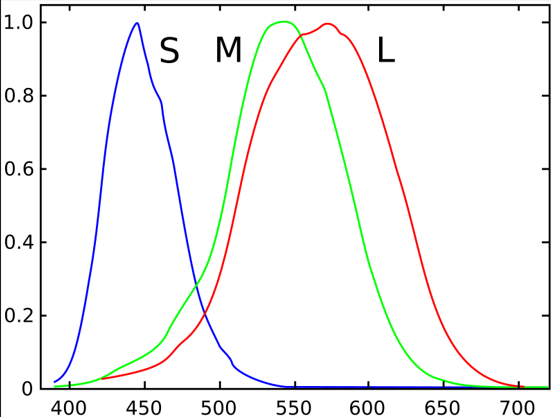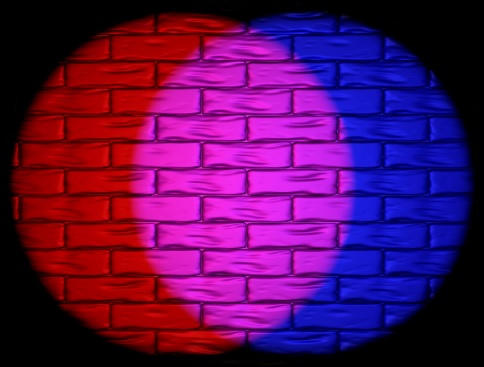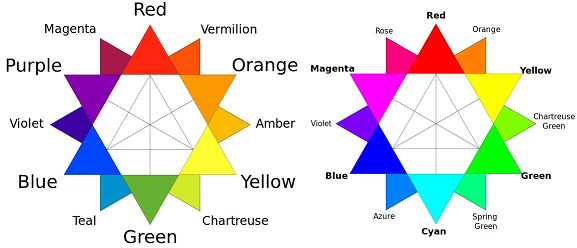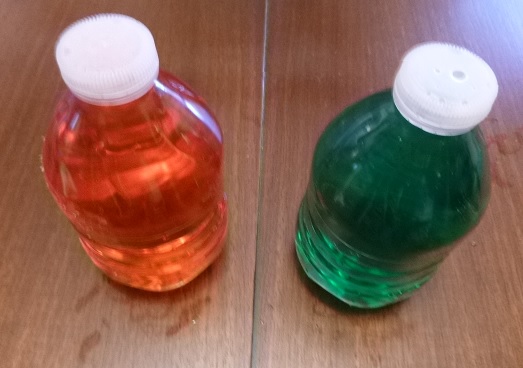
Photometry
Photons enter the eye through the optic lens, which, in the human eye, is controlled by muscles which flex it in order to focus the light on different portions of the retina, which absorbs the photon. Amongst the matter absorbing these photons are photoreceptive cells, rods, and cone cells. These cells are preferentially sensitive to light of varying wavelengths and intensity. The absorption of photonic energy catalyzes a reaction in a receptive protein molecule, of class known as opsins, creating a chain reaction of protein activity for the purposes of cell signaling. The degree and duration of this stimulus either excites or inhibits the cell, towards a threshold where the cell will be more or less inclined to fire, sending a bioelectrical signal to another kind of specialized nerve cell, as the first step of relaying the signal that carries information as to what has happened with that particular receptor into the optic nerve and ultimately into the brain, where the combined stimulus of all the receptors is amalgamated, filtered, and processed to create visual perception and the subjective experience of vision.
Rod cells and cone cells.
Photoreceptor cells convert light (visible electromagnetic radiation) into signals that can stimulate biological processes. Cone cells are photoreceptor cells in the retinas of vertebrate eyes and are responsible for color vision, functioning in bright light, whereas rod cells, work better in dim light. Rod cells have little role in color vision, which is the main reason why colors are much less apparent in dim light. There are 3 types of cone cells: S-cones, M-cones, and L-cones, for short, medium, and long. When violet light strikes the eye for example, the S-cone is stimulated strongly, and the L-cone stimulated weakly.
Thereís about 92 million rod cells in the human retina, and 4.5 million cone cells in the human eye.
Humans having red green and blue cones, instead of red green and violet cones, explains why in the Doppler effect, we call it blue shift instead of violet shift. Our red and green cones have a closer overlap, meaning we see yellow better because it affects both our red and green cones.

Now, there is a misconception. Our red cones are not actually red, they're peak is in the yellow range. The halfway point between red and green in the spectrum, is yellow, and if you Google'd what color do humans see the best, majority return green. But you can find a few, that actually say chartreuse, or whatever color is 555 nm. That is roughly 50% green and 50% yellow, so our red cones are mistakenly labeled red. This makes sense, as we cannot see in the IR. Unfortunately, the decision to call it red cones was already established by 1931, and it could have been due to marketing reasons.
Rhodopsin is a protein that is the opsin of rod cells in the retina. Rhodopsin reactions can take 50 femtoseconds.
The 6 types of photoreceptor proteins are: cryptochromes, phototropins, BLUF proteins, phytochromes, xanthopsins, and rhodopsins. Only the 1st 3 bind to flavins, while the last 3 use other chromophores to absorb light. Flavins are always yellow in their oxidized form (not reduced). However, only the 1st and 6th are found in animals.
Cryptochromes are found in animals, plants, and bacteria, and regulate circadian rhythm. Phototropins are primarily found in plants and algae. BLUF proteins (blue light using FAD) are found in bacteria and some algae. Phytochromes are found in plants, fungi, and bacteria, and bind to a chromophore called bilin (usually phytochromobilin). Xanthopsins are primarily found in bacteria. Rhodopsins are found in animals, fungi, and bacteria.
Reflective light.
Most materials have some absorption cutoff where shorter-wavelength radiation cannot penetrate, because it moves an electron across a band gap. Metals tend to reflect radiation from radio waves to UV. But colored metals like copper and gold donít reflect the shorter wavelength (Webb space telescope cannot see blue or UV reflected from gold).
In 2020, 3-hydroxyisonicotinaldehyde (also known as 3-hydroxypyridine-4-carboxaldehyde), has the lowest molecular weight of all dyes, which exhibits green fluorescence.
Do animals see color?
Animals such as rabbits and alligators, lack the red cone, but do have the blue and green cone. That generally means they can see blue and green the same way we do, but not red.
Most birds see orange through ultraviolet. Few birds can see into the red range of the spectrum. Other animals like bumblebees cannot see into the red spectrum. Turtles, however, see an excess of red, and they can also see ultraviolet. It is a myth that goldfish can see from ultraviolet to infrared, and it turns out no known animal can. And the birds and turtles that see into ultraviolet, see into UV-A, not UV-B.
-
1. If animals such as rabbits and alligators, lack the red cone, but do have the blue and green cone. Then do any animals lack the green cone, but do have the red and blue cone?
The problem with humans, is that out S (short) and M (medium) cones are so close aligned, that when an animal does have only 2 cones, it's hard to say whether the shorter cone, is for S or M. Note that for humans, the red cone is mistakenly called red. The red (or S) cone, is actually in the red region. The idea of calling them blue, green, and red cones, instead of blue, green, and yellow cones, was already decided by 1931, and may have been due to marketing reasons.
While no common animal species are documented to naturally possess only red and blue cones, itís theoretically possible through genetic mutations.
Most animals that have only 2 cones, are in the blue, and yellow-green region, such as freshwater fish. Note that orange or red cones is especially unuseful in underwater environments, as red light are often filtered out by water.
2. What about lacking the blue cone, but have the red and green cone?
Still no.
3. What animals have only 1 cone, and what color does it fall under?
Seals and whales, and it's believed they've lost the blue cone from evolution, and the only other cone they have is for seeing green. Whales and dolphins only see into the yellow-green region, with seals, sea lions, and walruses only seeing into the green region. In deep water, having a cone sensitive to green-yellow helps with contrast detections against a blue background.
3. Any animals with other combinations?
Dogs and wolves do not see red or green, and only see blue and yellow (and therefore brown and gray). Dogs have 2 types of cone cells in their retinas: blue-sensitive cones (L-cones) and yellow-sensitive cones (similar to human yellow cones or S-cones). Because dogs cannot see red, then they see purple without the red, so purple looks blue to them.
Note: it should be noted that most people believed dogs were completely colorblind, especially due to optometrist Gordon Walls publishing a book in 1942, "The Vertebrate Eye and Its Adaptive Radiation." But that belief was debunked by 1989, when ophthalmologist Dr. Jay Neitz, then at the University of California, Santa Barbara, and his colleagues discovered that canines could see blues and yellows but not reds and greens.
4. What other animals have 3 cones?
Besides the primates, animals that are like humans and have 3 cones include many fish (goldfish) and lizards.
5. Which animals have 4 or more cones?
Most birds have 4 cones, allowing them to see more into the UV. The Mantis shrimp holds the record at 16 cones.
6. What happens when you mix red and blue?
It depends on whether you meant paint or light. For paint, then purple, and for light, then magenta.

The following is an image off 500 red and blue pixels side by side. You can try to download it, then zoom-in to see the distinct pixels.

Now, as far as making side by side pixels of other colors, keep in mind that your computer or smartphone screen uses red green and blue pixels, so if I used other colors, are not represented by the light of your screen.
7. What happens when you mix red and green?

It also depends on what you mean by green. For red and blue, they are essentially the same between the paint-model of colors, and light-model of colors.
The paint model shows a darker green, whereas the light model shows a lighter, lime green.
Therefore, the word green is often used to represent 2 different colors. Below is an example of mixing red and green liquid.

However, unfortunately, the red liquid is not that red to me. It is a bit to the orange side. Another dye I bought, was more orange than this.